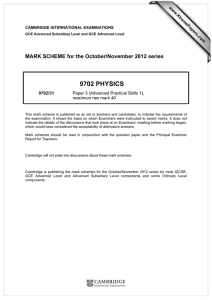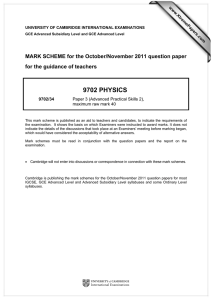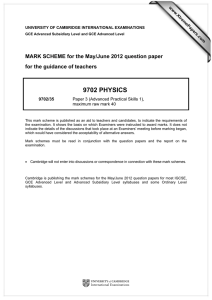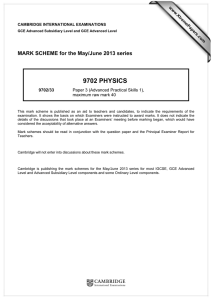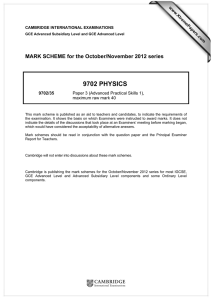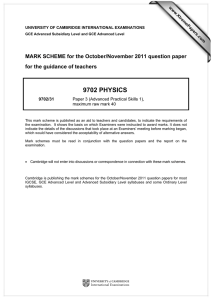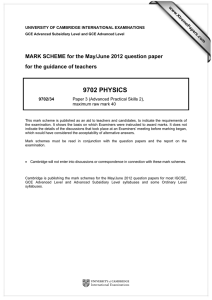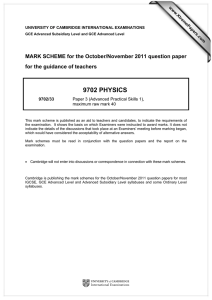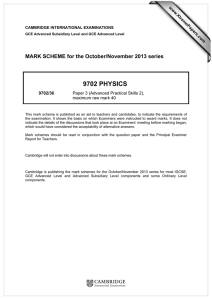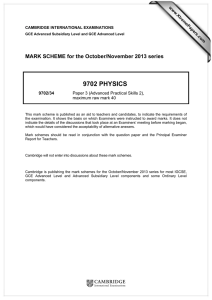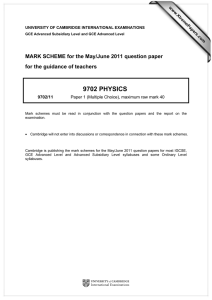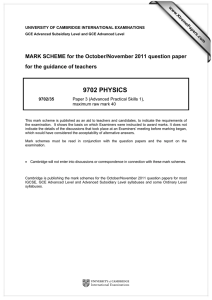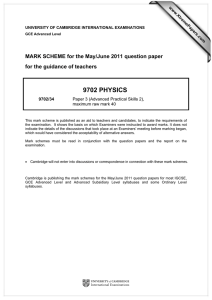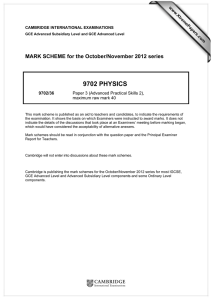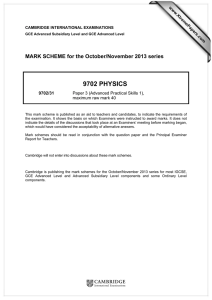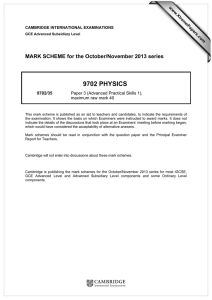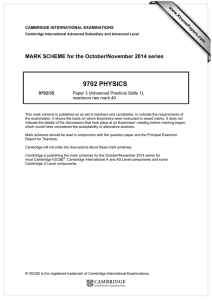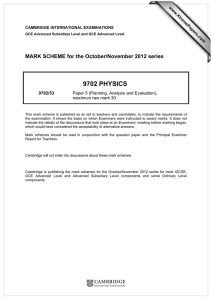9702 PHYSICS MARK SCHEME for the October/November 2012 series
advertisement
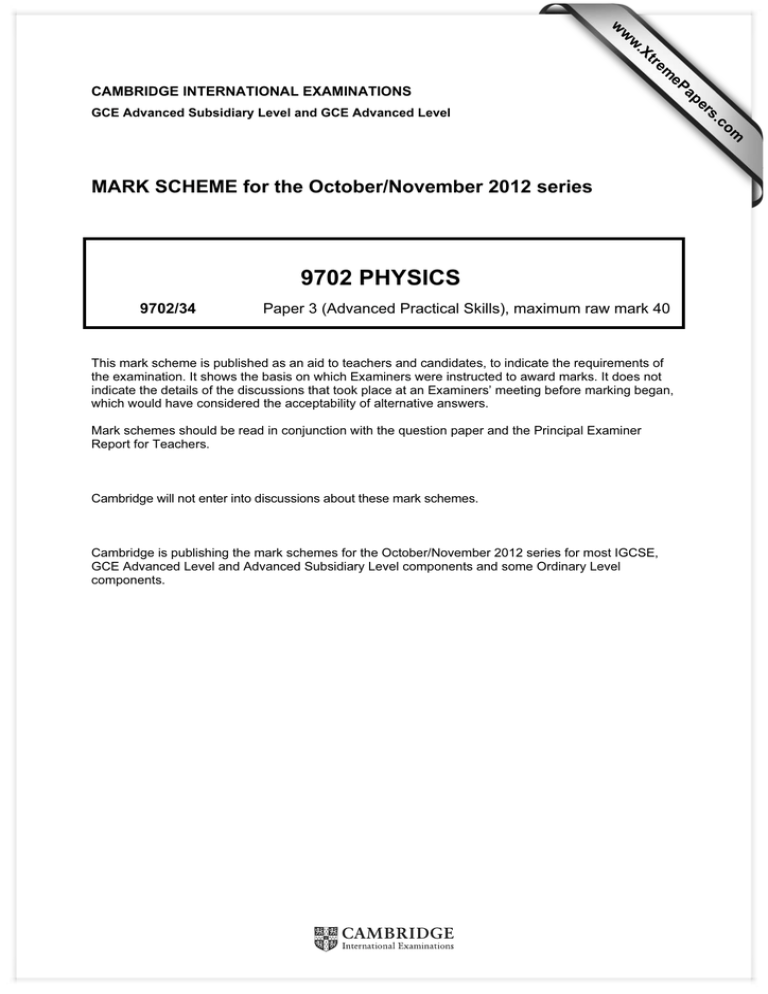
w w ap eP m e tr .X w CAMBRIDGE INTERNATIONAL EXAMINATIONS 9702 PHYSICS 9702/34 Paper 3 (Advanced Practical Skills), maximum raw mark 40 This mark scheme is published as an aid to teachers and candidates, to indicate the requirements of the examination. It shows the basis on which Examiners were instructed to award marks. It does not indicate the details of the discussions that took place at an Examiners’ meeting before marking began, which would have considered the acceptability of alternative answers. Mark schemes should be read in conjunction with the question paper and the Principal Examiner Report for Teachers. Cambridge will not enter into discussions about these mark schemes. Cambridge is publishing the mark schemes for the October/November 2012 series for most IGCSE, GCE Advanced Level and Advanced Subsidiary Level components and some Ordinary Level components. om .c MARK SCHEME for the October/November 2012 series s er GCE Advanced Subsidiary Level and GCE Advanced Level Page 2 1 Mark Scheme GCE AS/A LEVEL – October/November 2012 Syllabus 9702 Paper 34 (a) (iii) Value for I0 in range 100 to 200 mA, with consistent unit. [1] (b) l in range 40.0 to 60.0 cm, with consistent unit. [1] (c) Six sets of readings of l and I scores 5 marks, five sets scores 4 marks etc. –1 for minor help from Supervisor, –2 for major help. Incorrect trend / no l data / no I data then –1 [5] Range: lmax – lmin ≥ 60 cm. [1] Column headings: Each column heading must contain a quantity and a unit. The unit must conform to accepted scientific comvention e.g. I /mA or I (mA) or 1/ I (mA–1) but not 1/I (mA) and not 1/I (mA)–1. [1] Consistency: All values of l must be given to the nearest mm [1] Significant figures: All values of 1/I must be given to the same number of s.f. (or one more than) the s.f. in the corresponding values of I. [1] Calculated values: Values of 1/I calculated correctly. [1] (d) (i) Axes: Sensible scales must be used, no awkward scales (e.g. 3:10). Scales must be chosen so that the plotted points must occupy at least half the graph grid in both x and y directions. Scales must be labelled with the quantity that is being plotted. Scale markings must be no more than 3 large squares apart. [1] Plotting of points: All the observations in the table must be plotted on the grid. Diameter of plots must be ≤ half a small square. Points must be plotted accurately. Work to an accuracy of half a small square in both x and y directions. [1] Quality: All points in the table must be plotted (at least 5) for this mark to be scored. Quality is assessed by the scatter of the points about a straight line – all points must be within 0.025 m2 (in the l2 direction) of the line. [1] (ii) Line of best fit: Judge by balance of all the points on the grid (at least 5) about the candidate's line. There must be an even distribution of points either side of the line along the full length. One anomalous point is allowed only if clearly indicated (i.e. circled or labelled) by the candidate. Line must not be kinked or thicker than half a square. [1] © Cambridge International Examinations 2012 Page 3 Mark Scheme GCE AS/A LEVEL – October/November 2012 Syllabus 9702 Paper 34 (iii) Gradient: Value must be negative if graph gradient is negative. The hypotenuse of the triangle must be greater than half the length of the drawn line. Both read-offs must be accurate to half a small square in both x and y directions. Method of calculation must be correct. [1] y-intercept: Either: Correct read-off from a point on the line, and substitution into y = mx + c. Read-off must be accurate to half a small square in both x and y directions. Or: Intercept read directly from the graph. [1] (e) Value of a = candidate’s gradient and value of b = candidate’s intercept. A value presented as a fraction is not allowed. Unit for a consistent with value, e.g. mA–1cm–2. [1] [1] [Total: 20] 2 (a) Value of d in range 68.0 to 72.0 cm, with unit [1] (c) (i) h1 and h2 recorded to nearest mm and h1 > h2. [1] (ii) Correct calculation of sinθ. [1] (d) Justification for s.f. linked to s.f in (h1–h2) and s.f. in d. [1] (e) Raw values of t in range 1 to 20 s, with unit. [1] Evidence of repeated measurements for t. [1] (f) Percentage uncertainty in t based on absolute uncertainty of 0.1 or 0.2 or 0.3 s (or half the range if it isn’t zero). Correct method of calculation to get percentage uncertainty. [1] (g) (ii) Second values of h1 and h2. [1] Second value of t. [1] Quality: t smaller for larger (h1–h2). [1] © Cambridge International Examinations 2012 Page 4 Mark Scheme GCE AS/A LEVEL – October/November 2012 Syllabus 9702 Paper 34 (h) (i) Correct calculation of two values of k. [1] (ii) Valid conclusion based on the calculated values of k. Candidate must test against a stated criterion. [1] (i) (i) Limitations 4 max. (ii) Improvements 4 max. take more readings and plot a graph / Calculate more k values and compare Do not credit A two results not enough B rolling is erratic / marble not round / track uneven C parallax error in measuring h description of valid method of reducing parallax error in h (e.g. extend mark to wood or track / pointer on rule / travelling microscope*) view at right angles / eye level / use shadow method D difficult to stop stopwatch at correct moment / reaction time (or human error) linked to stopping of stopwatch use video of marble and clock / lightgate and timer motion sensor at end of track / view frame by frame ‘timegates’/ ‘timergates’ / just ‘reaction time’ E small difference between h1 and h2 / large uncertainty in h1– h2 vernier caliper use longer track*/ use (named) more precise method (e.g.travelling microscope*) F difficult to release marble without applying a force / velocity description of mechanical method of releasing (e.g. electromagnet with steel / magnetic material ball) use a clamp / remote controlled clamp G t is small/ large uncertainty in t / ball moves fast so difficult to time accurately use longer track*/ increase d human reaction error ‘repeat readings’ on its own / ‘few readings’ / ‘take more readings and (calculate) average k’ / ‘only one reading’ too much friction * only credited once each. Do not allow ‘repeated readings’ Do not allow ‘use a computer to improve the experiment’ [Total: 20] © Cambridge International Examinations 2012
